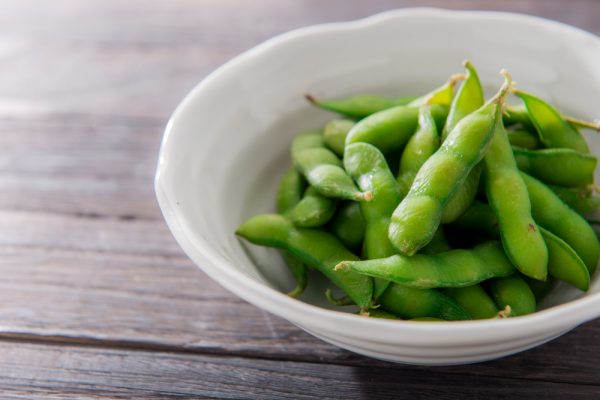Edamame is a delicious Japanese dish of fresh young soybeans nestled in their pods. Boiled or steamed and sprinkled with salt, edamame is traditionally served as a snack in Japanese restaurants with beer or sake.
In addition to their deliciousness, these tiny green beans have shown they can promote health—from lowering cholesterol and supporting healthy weight loss to protecting against certain cancers.
Although popular in Japan, soybeans originated in China and were introduced to Japan around the eighth century.
Soybeans are the main ingredient in soy sauce and have a long history throughout Asia, where they are used to make many traditional foods such as soymilk, soy nuts, tofu, tempeh, miso, natto, and yuba—the skin that forms on the surface of heated soy milk.
Edamame comes from the Japanese “eda,” which means branch or stem, and “mame” which means bean, as they were traditionally sold with the pods still attached to their branches. Today, edamame comes fresh or frozen in pods or shelled for easy preparation.
Packed with nutrition and easy to incorporate into various dishes, edamame is a superb addition to a healthy diet and can benefit several common health conditions as well.
1. Packed With Nutrition
Edamame is low in calories and high in protein and fiber—making it a highly nutritious snack. It’s also rich in antioxidants, helping fight disease and oxidative stress. Edamame contains abundant vitamins and minerals, including vitamins C, B1, B2, E, A, and K, along with zinc, calcium, folate, copper, magnesium, and manganese.
Soybeans and other legumes also contain isoflavones—polyphenolic compounds that have demonstrated protective effects against some cancers. Isoflavones are “a class of flavonoids that exhibit antioxidant, anticancer, antimicrobial, and anti-inflammatory properties,” according to a review published in Nutrients. Isoflavones are phytoestrogens, which have caused concerns about their potential to fuel certain hormone-related cancers. However, recent studies suggest that these compounds reduce the risk of some cancers while also possessing other health benefits.
2. Supports Healthy Weight Loss
This tasty legume is an ideal addition to your diet to support healthy weight loss. Its high fiber content helps food move more slowly through the gastrointestinal tract, keeping you full or satiated longer. Research suggests that increasing the amount of fiber in our diet significantly decreases the risk of weight gain and accumulating fat.
Edamame’s high protein content also helps us feel full for longer, which one study demonstrated by comparing a high-protein breakfast with one high in carbohydrates. Those eating the high protein breakfast had reduced levels of ghrelin—a gut hormone that causes the sensation of hunger and stimulates appetite.
In a review of 22 trials published in 2019, soy consumption was found to significantly reduce body mass index, body weight, body fat percentage, and waist circumference in women who were overweight or obese. The study also noted that the effects were even more pronounced in non-menopausal women.
3. Eases Symptoms of Menopause
Menopause is a time when a woman’s natural estrogen levels begin to decline, which can cause a variety of symptoms such as night sweats, hot flashes, mood swings, and trouble sleeping. When faced with symptoms, some women undergo hormone replacement therapy while others opt for isoflavone supplements for relief.
A randomized controlled trial found that treatment with 60 milligrams (mg) of isoflavones daily reduced acute menopausal symptoms of night sweats (57 percent) and hot flashes (43 percent) after three months.
Another randomized controlled trial published in 2023 found that eating soybeans daily, in addition to maintaining a low-fat, vegan diet, “significantly reduced the frequency and severity of postmenopausal hot flashes and associated symptoms” in postmenopausal women with two or more “moderate to severe hot flashes daily.”
4. Helps Keep Bones Strong
Research suggests edamame’s abundant isoflavones may help keep bones strong.
In a study of postmenopausal women with low bone density, those receiving an isoflavone phytoestrogen genistein (found in soybeans) supplement over 24 months had increased bone density compared to those taking the placebo.
A meta-analysis of 52 trials also found that isoflavones from soy prevented bone loss due to osteoporosis, regardless of the person’s weight, ethnicity, or treatment duration.
5. Lowers Cancer Risk
Because of the phytoestrogens in soy—which can both mimic and block estrogen in the body—there have been concerns that high amounts can lead to hormone-related cancers, such as cancers of the breast, prostate, ovaries, and thyroid. However, recent studies have shown that isoflavones (a type of phytoestrogen) are associated with a reduction in cancer risk.
A 2020 meta-analysis of more than 300,000 Chinese women investigated if there was a connection between soy intake and an increased risk of breast cancer. Researchers found that every 10 mg per day increase in soy intake was associated with a 3 percent reduction in breast cancer risk—leading researchers to conclude that moderate soy consumption didn’t increase breast cancer risk. The study also noted that a higher soy intake may prevent breast cancer.
A 2022 review found that soy isoflavone consumption reduced the risk of breast cancer in pre- and postmenopausal women.
A review using data collected from 1975 to 2015 found that isoflavones protect against prostate cancer. The study also notes that when using isoflavones in the treatment or prevention of prostate cancer, “careful consideration should be given.”
Another study found that soy isoflavones prevented the spread of malignant prostate cells, and a review found that isoflavones make cancer cells more sensitive to radiation therapy.
Although the above studies found that isoflavones were protective against cancer, it’s a complex issue with many factors to consider.
Soy and Cancer
Although consuming soy can be a controversial topic, recent studies (including those above) and thousands of years of consumption throughout Asia suggest it’s a safe option to incorporate into a healthy diet, with a few caveats.
In the United States, most soy (a subsidized crop) is genetically modified and sprayed with pesticides, so if you choose to include it in your diet, try to find a non-GMO, organic source.
Throughout much of East Asia, soy intake is mainly from whole and fermented soy products such as miso, natto, and tempeh, which aren’t grown and processed the way they are in the United States. This is likely one reason that East Asian populations have lower cancer rates than we do in the United States. These fermented foods produce unique metabolites known to combat cancer, heart disease, and more.
Highly processed soy products, such as soy oil, are ubiquitous in many processed foods we eat in the West—so read labels to ensure you aren’t consuming these unhealthy soy products, opting instead for unprocessed, whole foods whenever possible.
Final Thoughts
Regardless of your stance on soy, edamame remains a wildly popular dish in Japan and throughout East Asia. In recent decades, edamame has become widespread in restaurants and grocery stores in the West for its nutritional profile and health benefits. If you have never had edamame or are just curious, it’s definitely worth a try—it’s an incredibly versatile legume, easy to use, and tastes great.




